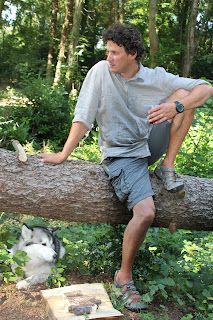 |
| Volunteer Wes Fack makes stop cuts in pine bark with a bone chisel and a club of green ash. |
Previous experiments had shown that antler chisels were more effective in removing the xylem (wood) since the bone tended to chip. But these experiments were done on oak. Even seasoned pine was soft enough to split tangentially using the bone. The advantage is over antler is that the bone offers a broader surface area, so fewer stop cuts had to be made, and it removed wider pieces of debitage from the log.
 |
| Broad, flat wood removed from pine log with a bone chisel. |
 |
| Seasoned pine was soft enough that the bone could be used without damaging the tool, and it removed greater amounts of wood with the same effort. |
At the end of the day (and after a pretty gnarly wasp attack!), the pine log also made a great bench for relaxing with a cool beverage and humankind's best friend!
 |
| A well-earned breather! |
Next we turned to waterlogged wood because, knowing
how opportunistic people are, one of the research questions
is whether or not it would have been more efficient in some
cases to work with waterlogged wood. Waterlogged wood
would be softer and more malleable, and smaller logs
could even have been pilfered from beaver dams.
There wasn't much to choose from in the Tickleford creek,
so we opted to plant a variety of logs in the water: pine,
hazel, holly, and alder. We'll let them soak for awhile and
then see how their new condition affects their workability.
 |
| Can you spot the helpful dragonfly? |
Since it was a convenient target, we worked next with a seasoned silver birch log that lay next to the stream. As expected, the bark was easily removed using our favorite bone chisel and a holly-wood club. However, the wood was much harder than expected.
 |
| Action shot of antler chisel sending a birch wood chip flying. |
And what's more, its workability decreased even further when the direction changed: that is, when splitting from the bottom of the tree toward the top, it was difficult, but when splitting from the top of the tree toward the bottom, the wood splintered and frayed. In the photo below, it is
evident from the size of the wood chips
which direction proved more efficient. What is
also evident is that our ancestors would have
known the difference too, and would have
made sure to maximize their efforts.
 |
| Seasoned birch log worked from lower on the trunk (left) and higher on the trunk (right) to reveal differences in the two. |
No comments:
Post a Comment